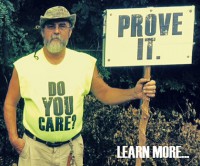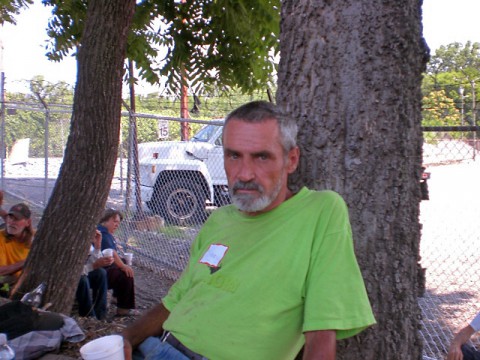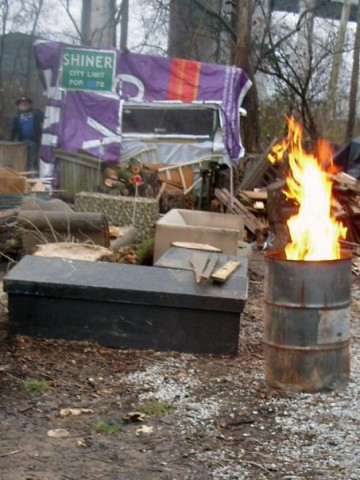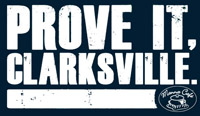An exercise in homelessness.
 Clarksville, TN – Hi all, Vicki here. Last night, Kenny (like most homeless folks) took the opportunity to work a side job and make a few dollars, so he got back to his camp very late—and then he had to get up super-early to get to his bus stop on time.
Clarksville, TN – Hi all, Vicki here. Last night, Kenny (like most homeless folks) took the opportunity to work a side job and make a few dollars, so he got back to his camp very late—and then he had to get up super-early to get to his bus stop on time.
So he didn’t have a chance to blog about yesterday’s “adventures,” but he’ll catch up tomorrow. In the meantime, here’s something he wrote the other night while at camp:
The face of homelessness has changed over the past few years.

While there are some that might resemble that stereotype, they’re not as common as Hollywood portrays—at least not anymore.
The look of homelessness actually changes from region to region. For instance, on the streets of Seattle I saw many who lived in city parks and slept on benches or in alleys, curled up under a blanket.
While in Nashville, when I was going into Tent City, I saw people living in everything from tents to shacks they’d made out of scrap pallets and discarded vinyl from old billboard signs. Some had fire pits, and others even had makeshift wood burning stoves to keep them warm in the winter.

When I first started working the streets of Clarksville, I was surprised at the lack of resources; for instance, one of the first homeless camps I saw was along some railroad tracks, and it was nothing more than a piece of clear plastic with a blanket underneath. This was during winter, but there was no way for this person to create heat.
Other camps do have tents, or at least tarps or lean-tos for shelter—and sometimes these are under bridges. And then there are those who live in their cars. They’re peppered all across this city as well as the nation.
There are the chronically homeless; these are the ones for whom homelessness has become a lifestyle. I refuse to believe that anyone sets out to become homeless for the rest of their lives. But for whatever reason, they become homeless and never seem to get a second chance, or at least one that works for them … so they adapt and try to make the best of it. I call this “remodeling the pigpen.”
Like the man in the story of the Prodigal Son, they need to come to their senses and start the journey out, but they’re stuck in this pigpen called homelessness, so they try to fix it up—they sweep and maybe even put up curtains, but at the end of the day it’s still a pigpen. Some just need a little help finding the way out, and that’s where you and I come in.
This is one situation where you see homeless children because some people just don’t have family to whom they can send the kids to keep them off the streets. This kind of homelessness increased during the housing crash, when so many folks lost their homes.
And then there are the transient folks, who stay with friends or relatives. If their support system “runs out,” they become totally homeless.
Seventeen years ago, I would have fallen into two of these categories. I was never chronically homeless, but I just couldn’t seem to get ahead. Sometimes this was because of bad choices and sometimes it wasn’t. Either way, I got a divorce and moved out of the house with no place to go, so I slept in my truck. But I was able to develop a support system fairly quickly, so I had a place to stay at least part of the time.
 So I was on the streets part of the week and spent the night with friends part of the week—that way, I could take a shower so I could work and start to get back on my feet. When someone loses almost everything and is homeless—or in my case, transient—they can’t just go get a job and then instantly go get an apartment. It takes at least a couple of months to save up enough to pay rent and utility deposits—at least it did for me.
So I was on the streets part of the week and spent the night with friends part of the week—that way, I could take a shower so I could work and start to get back on my feet. When someone loses almost everything and is homeless—or in my case, transient—they can’t just go get a job and then instantly go get an apartment. It takes at least a couple of months to save up enough to pay rent and utility deposits—at least it did for me.
The most unsettling sight of all is the look on a person’s face the very first night they’re homeless. You can spot them a mile away—the ones with “that look” that reveals what they’re thinking: How did I get here? I’ve got nothing left, and I’m scared to death. The ones who ask you, Do you know where I can find a place to stay? Those are the things that haunt you. Those are the faces that keep you up at night. Those are the faces that make homelessness real.
Until next time…
One way you can “Prove It” that takes less than a minute: sign the petition to show your support of a full-time transitional homeless shelter:


